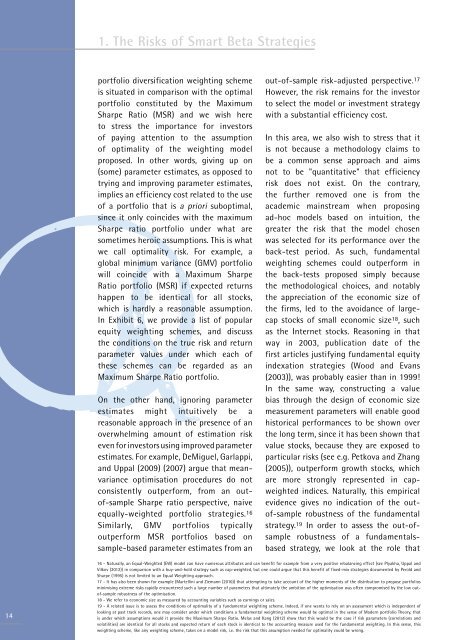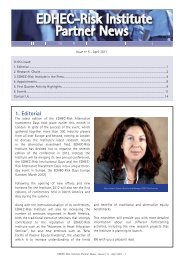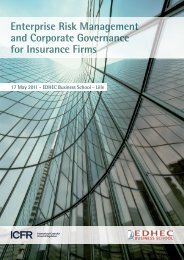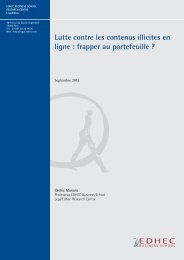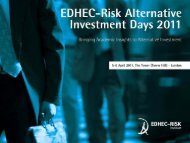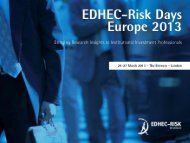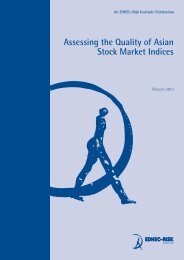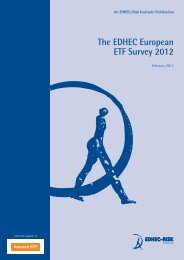Smart Beta 2.0 - EDHEC-Risk
Smart Beta 2.0 - EDHEC-Risk
Smart Beta 2.0 - EDHEC-Risk
You also want an ePaper? Increase the reach of your titles
YUMPU automatically turns print PDFs into web optimized ePapers that Google loves.
1. The <strong>Risk</strong>s of <strong>Smart</strong> <strong>Beta</strong> Strategies<br />
portfolio diversification weighting scheme<br />
is situated in comparison with the optimal<br />
portfolio constituted by the Maximum<br />
Sharpe Ratio (MSR) and we wish here<br />
to stress the importance for investors<br />
of paying attention to the assumption<br />
of optimality of the weighting model<br />
proposed. In other words, giving up on<br />
(some) parameter estimates, as opposed to<br />
trying and improving parameter estimates,<br />
implies an efficiency cost related to the use<br />
of a portfolio that is a priori suboptimal,<br />
since it only coincides with the maximum<br />
Sharpe ratio portfolio under what are<br />
sometimes heroic assumptions. This is what<br />
we call optimality risk. For example, a<br />
global minimum variance (GMV) portfolio<br />
will coincide with a Maximum Sharpe<br />
Ratio portfolio (MSR) if expected returns<br />
happen to be identical for all stocks,<br />
which is hardly a reasonable assumption.<br />
In Exhibit 6, we provide a list of popular<br />
equity weighting schemes, and discuss<br />
the conditions on the true risk and return<br />
parameter values under which each of<br />
these schemes can be regarded as an<br />
Maximum Sharpe Ratio portfolio.<br />
On the other hand, ignoring parameter<br />
estimates might intuitively be a<br />
reasonable approach in the presence of an<br />
overwhelming amount of estimation risk<br />
even for investors using improved parameter<br />
estimates. For example, DeMiguel, Garlappi,<br />
and Uppal (2009) (2007) argue that meanvariance<br />
optimisation procedures do not<br />
consistently outperform, from an outof-sample<br />
Sharpe ratio perspective, naive<br />
equally-weighted portfolio strategies. 16<br />
Similarly, GMV portfolios typically<br />
outperform MSR portfolios based on<br />
sample-based parameter estimates from an<br />
out-of-sample risk-adjusted perspective. 17<br />
However, the risk remains for the investor<br />
to select the model or investment strategy<br />
with a substantial efficiency cost.<br />
In this area, we also wish to stress that it<br />
is not because a methodology claims to<br />
be a common sense approach and aims<br />
not to be "quantitative" that efficiency<br />
risk does not exist. On the contrary,<br />
the further removed one is from the<br />
academic mainstream when proposing<br />
ad-hoc models based on intuition, the<br />
greater the risk that the model chosen<br />
was selected for its performance over the<br />
back-test period. As such, fundamental<br />
weighting schemes could outperform in<br />
the back-tests proposed simply because<br />
the methodological choices, and notably<br />
the appreciation of the economic size of<br />
the firms, led to the avoidance of largecap<br />
stocks of small economic size 18 , such<br />
as the Internet stocks. Reasoning in that<br />
way in 2003, publication date of the<br />
first articles justifying fundamental equity<br />
indexation strategies (Wood and Evans<br />
(2003)), was probably easier than in 1999!<br />
In the same way, constructing a value<br />
bias through the design of economic size<br />
measurement parameters will enable good<br />
historical performances to be shown over<br />
the long term, since it has been shown that<br />
value stocks, because they are exposed to<br />
particular risks (see e.g. Petkova and Zhang<br />
(2005)), outperform growth stocks, which<br />
are more strongly represented in capweighted<br />
indices. Naturally, this empirical<br />
evidence gives no indication of the outof-sample<br />
robustness of the fundamental<br />
strategy. 19 In order to assess the out-ofsample<br />
robustness of a fundamentalsbased<br />
strategy, we look at the role that<br />
14<br />
16 - Naturally, an Equal-Weighted (EW) model can have numerous attributes and can benefit for example from a very positive rebalancing effect (see Plyakha, Uppal and<br />
Vilkov (2012)) in comparison with a buy-and-hold strategy such as cap-weighted, but one could argue that this benefit of fixed-mix strategies documented by Perold and<br />
Sharpe (1995) is not limited to an Equal Weighting approach.<br />
17 - It has also been shown for example (Martellini and Ziemann (2010)) that attempting to take account of the higher moments of the distribution to propose portfolios<br />
minimising extreme risks rapidly encountered such a large number of parameters that ultimately the ambition of the optimisation was often compromised by the low outof-sample<br />
robustness of the optimisation.<br />
18 - We refer to economic size as measured by accounting variables such as earnings or sales.<br />
19 - A related issue is to assess the conditions of optimality of a fundamental weighting scheme. Indeed, if one wants to rely on an assessment which is independent of<br />
looking at past track records, one may consider under which conditions a fundamental weighting scheme would be optimal in the sense of Modern portfolio Theory, that<br />
is under which assumptions would it provide the Maximum Sharpe Ratio. Melas and Kang (2012) show that this would be the case if risk parameters (correlations and<br />
volatilities) are identical for all stocks and expected return of each stock is identical to the accounting measure used for the fundamental weighting. In this sense, this<br />
weighting scheme, like any weighting scheme, takes on a model risk, i.e. the risk that this assumption needed for optimality could be wrong.


